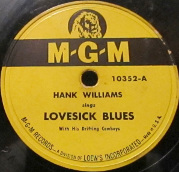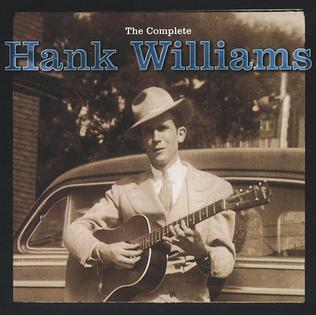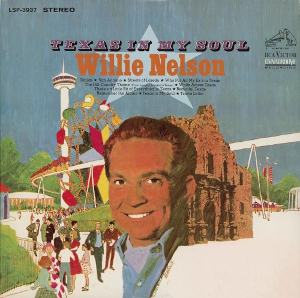
Nebraska is the sixth studio album by the American singer-songwriter Bruce Springsteen, released on September 30, 1982, by Columbia Records. Springsteen recorded the songs as demos on a 4-track recorder, intending to rerecord them with the E Street Band, but decided to release them as they were. Nebraska remains one of the most highly regarded albums in his catalogue, and was ranked number 150 in Rolling Stone's 2020 edition of its "The 500 Greatest Albums of All Time" list.

Ernest Dale Tubb, nicknamed the Texas Troubadour, was an American singer and songwriter and one of the pioneers of country music. His biggest career hit song, "Walking the Floor Over You" (1941), marked the rise of the honky tonk style of music.

The Importance of Being Ernest is an album by American country singer Ernest Tubb, released in 1959.
Country USA was a 23-volume series issued by Time-Life Music during the late 1980s and early 1990s, spotlighting country music of the 1950s through early 1970s.

"Lovesick Blues" is a Tin Pan Alley song, composed by Cliff Friend, with lyrics by Irving Mills. It first appeared in the 1922 musical "Oh, Ernest", and was recorded that year by Elsie Clark and Jack Shea. Emmett Miller recorded it in 1925 and 1928, followed by country music singer Rex Griffin in 1939. The recordings by Griffin and Miller inspired Hank Williams to perform the song during his first appearances on the Louisiana Hayride radio show in 1948. Receiving an enthusiastic reception from the audience, Williams decided to record his own version despite initial push back from his producer Fred Rose and his band.
This is a list of notable events in country music that took place in the year 1942.

The Complete Hank Williams is a 1998 box set collecting almost all of the recorded works of country music legend Hank Williams, from his first recorded track in 1947 to the last session prior to his untimely death in 1953 at the age of 29. While a number of live and overdubbed songs are excluded, the ten disc collection contains 225 tracks, including studio sessions, live performances and demos. Among those 225 songs are 33 hit singles and 53 previously unreleased tracks.

Texas in My Soul is the seventh studio album by country singer Willie Nelson. It was an early concept album that aimed to pay tribute to the State of Texas. The original album artwork features the Alamo, along with three San Antonio construction projects completed in 1968: the Tower of the Americas, HemisFair Arena and the HemisFair monorail system.

Country Favorites – Willie Nelson Style is the fourth studio album by country singer Willie Nelson. He recorded it with Ernest Tubb's band, the Texas Troubadours and Western Swing fiddler-vocalist Wade Ray with studio musicians Jimmy Wilkerson and Hargus "Pig" Robbins. At the time of the recording, Nelson was a regular on a syndicated TV show hosted by Tubb.

All Time Hits is an album by American country singer Ernest Tubb and His Texas Troubadours, recorded and released in 1960. Despite the album title, it is not a compilation of Tubb's previous hits. The entire album consists of Tubb's covers of songs that had been hits for other country and honky-tonk singers.
"Take These Chains from My Heart" is a song by Hank Williams. It was written by Fred Rose and Hy Heath and was recorded at Williams' final recording session on September 23, 1952, in Nashville. The song has been widely praised; Williams' biographer Colin Escott deems it "perhaps the best song [Rose] ever presented to Hank...It was one of the very few songs that sounded somewhat similar to a Hank Williams song." Williams is backed by Tommy Jackson (fiddle), Don Helms, Chet Atkins, Jack Shook, and Floyd "Lightnin'" Chance (bass). In the wake of Williams' death on New Year's Day, 1953, the song shot to No. 1, his final chart-topping hit for MGM Records. Like "Your Cheatin' Heart," the song's theme of despair, so vividly articulated by Williams' typically impassioned singing, reinforced the image of Hank as a tortured, mythic figure.
"Honky Tonkin'" is a 1947 country music song, written and recorded by Hank Williams. His song went to #14 on the Billboard country music chart in 1948. In 1982, it became the sixth chart topping single for Williams' son, Hank Williams Jr.
"Mind Your Own Business" is a 1949 song written and originally performed by Hank Williams.
"My Bucket's Got a Hole in It" is a song widely attributed to Clarence Williams, who obtained a copyright in 1933, although the melody was recorded under various names years earlier. The song became popular performed by Hank Williams for MGM and reached number 4 on the country chart in 1949.
"A Mansion on the Hill" is a song written by Hank Williams and Fred Rose and originally recorded by Williams on MGM Records. It peaked at No. 12 on the Most Played Jukebox Folk Records chart in March 1949.
Six More Miles (To the Graveyard) is a song written by Hank Williams for MGM Records. It appeared as the B-side to "I Saw the Light" in 1948.
"Let's Turn Back the Years" is a song written and originally recorded by Hank Williams for MGM Records.

Moanin' the Blues is the second album by American country musician Hank Williams, released on MGM Records in 1952.
"Faded Love and Winter Roses" is a song written by Fred Rose. It was released as a posthumous single by Hank Williams, whose records Rose produced, in 1954.
"Just One More" is a 1956 country music song by American artist George Jones. It was released as a single on Starday Records in 1956 reached #3 on the Billboard country singles chart. The song is often featured on his early compilation albums and was one of the most successful of his self-penned songs.









